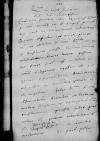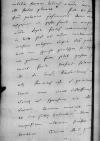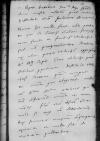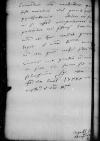Nuntius Reverendissimae Paternitatis Vestrae incidit in id tempus, quando Sigismund II Augustus Jagiellon (Zygmunt II August) (*1520 – †1572), 1529-1572 Grand Duke of Lithuania (ruled from 1544); 1530-1572 King of Poland (crowned vivente rege (ruled from 1548, after the death of his father); son of Sigismund I Jagiellon and Bona Sforza⌊rexSigismund II Augustus Jagiellon (Zygmunt II August) (*1520 – †1572), 1529-1572 Grand Duke of Lithuania (ruled from 1544); 1530-1572 King of Poland (crowned vivente rege (ruled from 1548, after the death of his father); son of Sigismund I Jagiellon and Bona Sforza⌋ erat in venationes abiturus. Quare difficulter ego written over i⌈ioo written over i⌉ omnia peregi tamen, quae volebat Dominatio Vestra Reverendissima, cui et Council of Royal Prussia the most important local authority in Royal Prussia. It consisted of two bishops (of Ermland (Warmia), who served as the Council’s president, and of Kulm (Chełmno)), three voivodes (of Kulm, Marienburg (Malbork), and Pomerania), three castellans (of Kulm, Elbing (Elbląg), and Gdańsk (Danzig)), three chamberlains (of Kulm, Marienburg, and Pomerania), and representatives of the three Great Prussian Cities – Gdańsk, Thorn (Toruń), and Elbing (ACHREMCZYK 2016, p. 17-18)⌊dominis consiliariis PrussiaeCouncil of Royal Prussia the most important local authority in Royal Prussia. It consisted of two bishops (of Ermland (Warmia), who served as the Council’s president, and of Kulm (Chełmno)), three voivodes (of Kulm, Marienburg (Malbork), and Pomerania), three castellans (of Kulm, Elbing (Elbląg), and Gdańsk (Danzig)), three chamberlains (of Kulm, Marienburg, and Pomerania), and representatives of the three Great Prussian Cities – Gdańsk, Thorn (Toruń), and Elbing (ACHREMCZYK 2016, p. 17-18)⌋ studium meum commendatum facere laboro. Possum hoc dicere, quod nisi industrie et summa diligentia egissem, ista, quae spectant confirmationem articulorum, res fuisset in conventum extracta et ibi impedita. Habet Reverendissima Dominatio Vestra confirmationem articulorum de verbo ad verbum scriptam ex exemplari Council of Royal Prussia the most important local authority in Royal Prussia. It consisted of two bishops (of Ermland (Warmia), who served as the Council’s president, and of Kulm (Chełmno)), three voivodes (of Kulm, Marienburg (Malbork), and Pomerania), three castellans (of Kulm, Elbing (Elbląg), and Gdańsk (Danzig)), three chamberlains (of Kulm, Marienburg, and Pomerania), and representatives of the three Great Prussian Cities – Gdańsk, Thorn (Toruń), and Elbing (ACHREMCZYK 2016, p. 17-18)⌊dominorum consiliariorum PrussiaeCouncil of Royal Prussia the most important local authority in Royal Prussia. It consisted of two bishops (of Ermland (Warmia), who served as the Council’s president, and of Kulm (Chełmno)), three voivodes (of Kulm, Marienburg (Malbork), and Pomerania), three castellans (of Kulm, Elbing (Elbląg), and Gdańsk (Danzig)), three chamberlains (of Kulm, Marienburg, and Pomerania), and representatives of the three Great Prussian Cities – Gdańsk, Thorn (Toruń), and Elbing (ACHREMCZYK 2016, p. 17-18)⌋, habet, quod voluit, de pecunia contributionis, de vexilliferatu superinscribed in place of crossed-out gladiferatu⌈gladiferatuvexilliferatuvexilliferatu superinscribed in place of crossed-out gladiferatu⌉, de conventus translatione. Si quid posthac  BCz, 1597, p. 140 iubebit, fac<i>am lubens omnia, nam illi studeo placere.
BCz, 1597, p. 140 iubebit, fac<i>am lubens omnia, nam illi studeo placere.
Fuit hic famulus hidden by binding⌈[ulus]ulus hidden by binding⌉ domini Janusz Latalski (†1557), brother of Jan Latalski, Archbishop of Gniezno; 1520-1529 Castellan of Ląd; 1529-1535 Castellan of Gniezno; 1535-1538 Voivode of Inowrocław; 1538-1557 Voivode of Poznań (PSB 16, p. 563; Urzędnicy 1/2, p. 211)⌊palatini PosnaniensisJanusz Latalski (†1557), brother of Jan Latalski, Archbishop of Gniezno; 1520-1529 Castellan of Ląd; 1529-1535 Castellan of Gniezno; 1535-1538 Voivode of Inowrocław; 1538-1557 Voivode of Poznań (PSB 16, p. 563; Urzędnicy 1/2, p. 211)⌋, qui verbis hidden by binding⌈[bis]bis hidden by binding⌉ exposuit, ut gesta sunt in Innsbruck (Oenipons), city in western Austria, Tyrol, on the Inn river⌊Eniponte hidden by binding⌈[te]te hidden by binding⌉Innsbruck (Oenipons), city in western Austria, Tyrol, on the Inn river⌋ omnia. Dixit factas caeremonias i[...] hidden by binding⌈[...][...] hidden by binding⌉ in lecto, sed ad talum tantummodo [...] hidden by binding⌈[...][...] hidden by binding⌉ incisam caligam dixit domino palatino, qui hidden by binding⌈[ino, qui]ino, qui hidden by binding⌉ lecto cum sponsa paulisper se deposuit hidden by binding⌈[uit]uit hidden by binding⌉, ut Gdańsk (Danzig, Dantiscum), city in northern Poland, on the Bay of Gdańsk at the mouth of the Vistula, on the Baltic, the biggest and wealthiest of the three Great Prussian Cities (Gdańsk, Thorn (Toruń), and Elbing (Elbląg)) with representation in the Council of Royal Prussia; a member of the Hanseatic League⌊GedaniGdańsk (Danzig, Dantiscum), city in northern Poland, on the Bay of Gdańsk at the mouth of the Vistula, on the Baltic, the biggest and wealthiest of the three Great Prussian Cities (Gdańsk, Thorn (Toruń), and Elbing (Elbląg)) with representation in the Council of Royal Prussia; a member of the Hanseatic League⌋ fieri solet, postea s[...] hidden by binding⌈[...][...] hidden by binding⌉tiones factae. Praefuit sollemnitati hidden by binding⌈[itati]itati hidden by binding⌉ illi dominus Bernhard von Cles (Bernardo Clesio, Bernhard von Glöss) (*1485 – †1539), humanist and diplomat; Chancellor of the King of Romans, Ferdinand I Habsburg (later Emperor), from 1515-1539 Bishop of Trent (appointed 1514), 1530 Cardinal, 1539 Bishop of Brixen⌊cardinalis TridentinusBernhard von Cles (Bernardo Clesio, Bernhard von Glöss) (*1485 – †1539), humanist and diplomat; Chancellor of the King of Romans, Ferdinand I Habsburg (later Emperor), from 1515-1539 Bishop of Trent (appointed 1514), 1530 Cardinal, 1539 Bishop of Brixen⌋ et alii. Tractatus(?) est Janusz Latalski (†1557), brother of Jan Latalski, Archbishop of Gniezno; 1520-1529 Castellan of Ląd; 1529-1535 Castellan of Gniezno; 1535-1538 Voivode of Inowrocław; 1538-1557 Voivode of Poznań (PSB 16, p. 563; Urzędnicy 1/2, p. 211)⌊dominus palatinusJanusz Latalski (†1557), brother of Jan Latalski, Archbishop of Gniezno; 1520-1529 Castellan of Ląd; 1529-1535 Castellan of Gniezno; 1535-1538 Voivode of Inowrocław; 1538-1557 Voivode of Poznań (PSB 16, p. 563; Urzędnicy 1/2, p. 211)⌋ [...] hidden by binding⌈[...][...] hidden by binding⌉tante or lante or laute⌈tantetante or lante or laute⌉, cum vero discessurus erat hidden by binding⌈[erat]erat hidden by binding⌉, venit ad Elisabeth of Austria (Elizabeth von Habsburg) (*1526 – †1545), Queen of Poland, Grand Duchess of Lithuania; first wife of Sigismund II August Jagiellon (1543-1545), daughter of Ferdinand I of Habsburg, and Anna Jagiellon⌊sponsamElisabeth of Austria (Elizabeth von Habsburg) (*1526 – †1545), Queen of Poland, Grand Duchess of Lithuania; first wife of Sigismund II August Jagiellon (1543-1545), daughter of Ferdinand I of Habsburg, and Anna Jagiellon⌋, ut illi vale hidden by binding⌈[vale]vale hidden by binding⌉diceret. Quam invenit ornatam hidden by binding⌈[atam]atam hidden by binding⌉ et duo serta habentem, alterum impositum, alterum sinistra manu hidden by binding⌈[anu]anu hidden by binding⌉ tentum. Quorum illud, quod hidden by binding⌈[d]d hidden by binding⌉  BCz, 1597, p. 141 in capite habebat, serenissimo Sigismund II Augustus Jagiellon (Zygmunt II August) (*1520 – †1572), 1529-1572 Grand Duke of Lithuania (ruled from 1544); 1530-1572 King of Poland (crowned vivente rege (ruled from 1548, after the death of his father); son of Sigismund I Jagiellon and Bona Sforza⌊regi sponsoSigismund II Augustus Jagiellon (Zygmunt II August) (*1520 – †1572), 1529-1572 Grand Duke of Lithuania (ruled from 1544); 1530-1572 King of Poland (crowned vivente rege (ruled from 1548, after the death of his father); son of Sigismund I Jagiellon and Bona Sforza⌋ dono misit, alterum, quod manu gestabat, domino Janusz Latalski (†1557), brother of Jan Latalski, Archbishop of Gniezno; 1520-1529 Castellan of Ląd; 1529-1535 Castellan of Gniezno; 1535-1538 Voivode of Inowrocław; 1538-1557 Voivode of Poznań (PSB 16, p. 563; Urzędnicy 1/2, p. 211)⌊palatinoJanusz Latalski (†1557), brother of Jan Latalski, Archbishop of Gniezno; 1520-1529 Castellan of Ląd; 1529-1535 Castellan of Gniezno; 1535-1538 Voivode of Inowrocław; 1538-1557 Voivode of Poznań (PSB 16, p. 563; Urzędnicy 1/2, p. 211)⌋ donavit.
BCz, 1597, p. 141 in capite habebat, serenissimo Sigismund II Augustus Jagiellon (Zygmunt II August) (*1520 – †1572), 1529-1572 Grand Duke of Lithuania (ruled from 1544); 1530-1572 King of Poland (crowned vivente rege (ruled from 1548, after the death of his father); son of Sigismund I Jagiellon and Bona Sforza⌊regi sponsoSigismund II Augustus Jagiellon (Zygmunt II August) (*1520 – †1572), 1529-1572 Grand Duke of Lithuania (ruled from 1544); 1530-1572 King of Poland (crowned vivente rege (ruled from 1548, after the death of his father); son of Sigismund I Jagiellon and Bona Sforza⌋ dono misit, alterum, quod manu gestabat, domino Janusz Latalski (†1557), brother of Jan Latalski, Archbishop of Gniezno; 1520-1529 Castellan of Ląd; 1529-1535 Castellan of Gniezno; 1535-1538 Voivode of Inowrocław; 1538-1557 Voivode of Poznań (PSB 16, p. 563; Urzędnicy 1/2, p. 211)⌊palatinoJanusz Latalski (†1557), brother of Jan Latalski, Archbishop of Gniezno; 1520-1529 Castellan of Ląd; 1529-1535 Castellan of Gniezno; 1535-1538 Voivode of Inowrocław; 1538-1557 Voivode of Poznań (PSB 16, p. 563; Urzędnicy 1/2, p. 211)⌋ donavit.
Nova hic nulla sunt alia praeter ea, quae de The Ottoman Turks (Turcae) ⌊Turcis The Ottoman Turks (Turcae) ⌋dudum scripsi. Iam sunt in finibus Duchy of Wal(l)achia (Valachia), country in central Europe stretching northwards from the lower Danube river, southern from the Duchy of Moldavia⌊ValachiaeDuchy of Wal(l)achia (Valachia), country in central Europe stretching northwards from the lower Danube river, southern from the Duchy of Moldavia⌋, sed non progrediuntur. The Tatars ⌊TartariThe Tatars ⌋ ex alia parte Valachum oppugnant. Regiae maiestatis capit(aneus) or capit(alis)⌈capit(aneus)capit(aneus) or capit(alis)⌉(?) cum Valacho pacem stabilivit perpetuam. Restituit Valachus terram, quam occuparat, et omnia, quae abegerat. Mittit ad Sigismund I Jagiellon (Zygmunt I) (*1467 – †1548), King of Poland and Grand Duke of Lithuania (1506-1548); Duke of Głogów (Glogau) (1499-1506), Duke of Opava (1501-1506), Governor of Silesia (1504-1506); son of King Kazimierz IV Jagiellon and Elisabeth of Austria⌊regiam maiestatemSigismund I Jagiellon (Zygmunt I) (*1467 – †1548), King of Poland and Grand Duke of Lithuania (1506-1548); Duke of Głogów (Glogau) (1499-1506), Duke of Opava (1501-1506), Governor of Silesia (1504-1506); son of King Kazimierz IV Jagiellon and Elisabeth of Austria⌋ oratores, qui litteris confirment omnia et iuramentis, filium etiam obsidem dare vult, si rex non detrectarit. Rex John Zápolya (János Szapolyai) (*1487 – †1540), 1526-1540 King of Hungary; son of István Szapolyai and Jadwiga of Cieszyn in 1540 married Isabella, dauther of of King Sigismund Jagiellon of Poland. He fought against Ferdinand of Habsburg for the right to the title of King of Hungary⌊IoannesJohn Zápolya (János Szapolyai) (*1487 – †1540), 1526-1540 King of Hungary; son of István Szapolyai and Jadwiga of Cieszyn in 1540 married Isabella, dauther of of King Sigismund Jagiellon of Poland. He fought against Ferdinand of Habsburg for the right to the title of King of Hungary⌋ magnum congregavit exercitum et multa sibi de victoria pollicetur.
 BCz, 1597, p. 142 Conventum nostri moliuntur pro festo Martini vel paulo post Piotrków (Petricovia), city in central Poland, in the 15th-16th century the location of the assemblies of the Diet (Sejm) of the Kingdom of Poland, today Piotrków Trybunalski⌊PyothrkoviaePiotrków (Petricovia), city in central Poland, in the 15th-16th century the location of the assemblies of the Diet (Sejm) of the Kingdom of Poland, today Piotrków Trybunalski⌋. Alia non sunt hidden by binding⌈[nt]nt hidden by binding⌉, et si essent, occupationes non paterentur ad praesens scribere. Nam et haec nescio quo modo hidden by binding⌈[odo]odo hidden by binding⌉ leget Dominatio Vestra Reverendissima ma[...] hidden by binding⌈[...][...] hidden by binding⌉tum or lum⌈tumtum or lum⌉ ita, quam nihil scribe[...] hidden by binding⌈[...][...] hidden by binding⌉.
BCz, 1597, p. 142 Conventum nostri moliuntur pro festo Martini vel paulo post Piotrków (Petricovia), city in central Poland, in the 15th-16th century the location of the assemblies of the Diet (Sejm) of the Kingdom of Poland, today Piotrków Trybunalski⌊PyothrkoviaePiotrków (Petricovia), city in central Poland, in the 15th-16th century the location of the assemblies of the Diet (Sejm) of the Kingdom of Poland, today Piotrków Trybunalski⌋. Alia non sunt hidden by binding⌈[nt]nt hidden by binding⌉, et si essent, occupationes non paterentur ad praesens scribere. Nam et haec nescio quo modo hidden by binding⌈[odo]odo hidden by binding⌉ leget Dominatio Vestra Reverendissima ma[...] hidden by binding⌈[...][...] hidden by binding⌉tum or lum⌈tumtum or lum⌉ ita, quam nihil scribe[...] hidden by binding⌈[...][...] hidden by binding⌉.
Cuius me gratiae commendo hidden by binding⌈[do]do hidden by binding⌉ et precor, ut sana sit et felicissima semper.
 BCz, 1597, p. 140 iubebit, fac<i>am lubens omnia, nam illi studeo placere.
BCz, 1597, p. 140 iubebit, fac<i>am lubens omnia, nam illi studeo placere. BCz, 1597, p. 141 in capite habebat, serenissimo
BCz, 1597, p. 141 in capite habebat, serenissimo  BCz, 1597, p. 142 Conventum nostri moliuntur pro festo Martini vel paulo post
BCz, 1597, p. 142 Conventum nostri moliuntur pro festo Martini vel paulo post 



